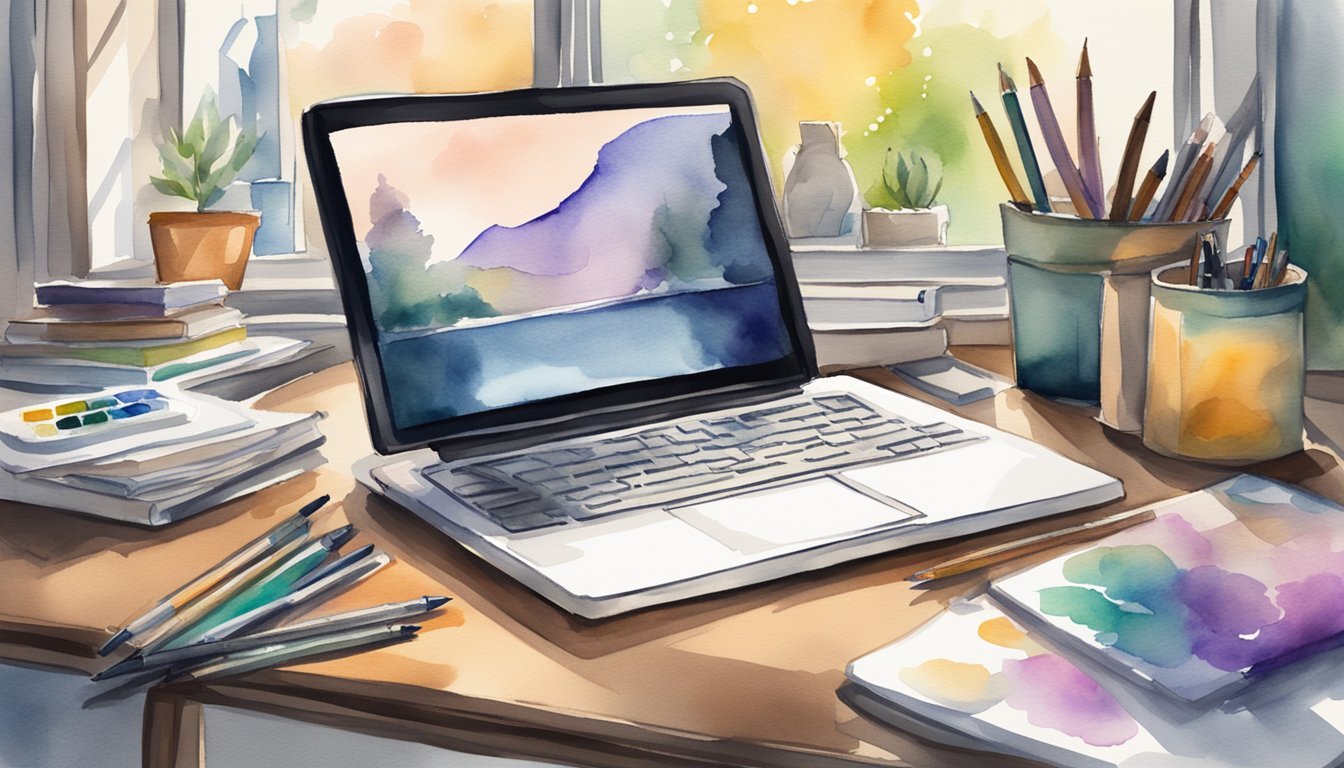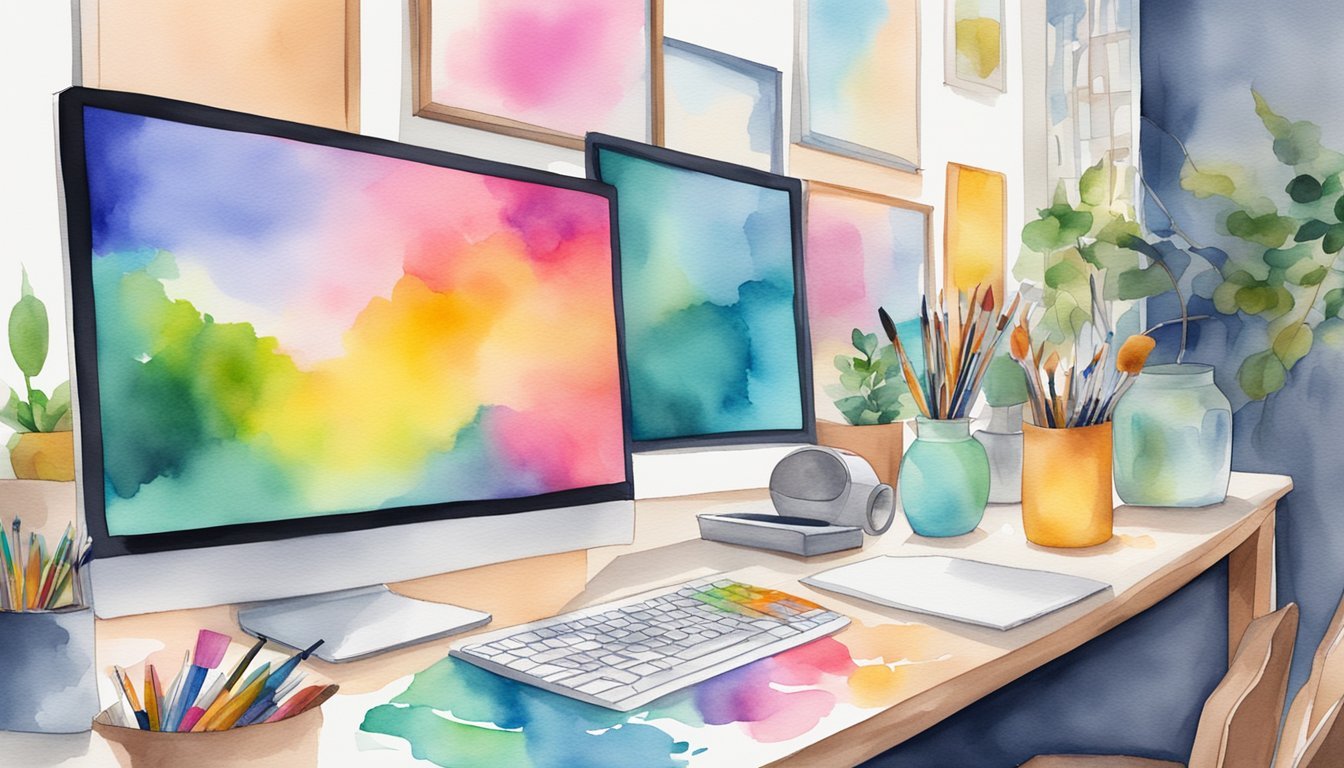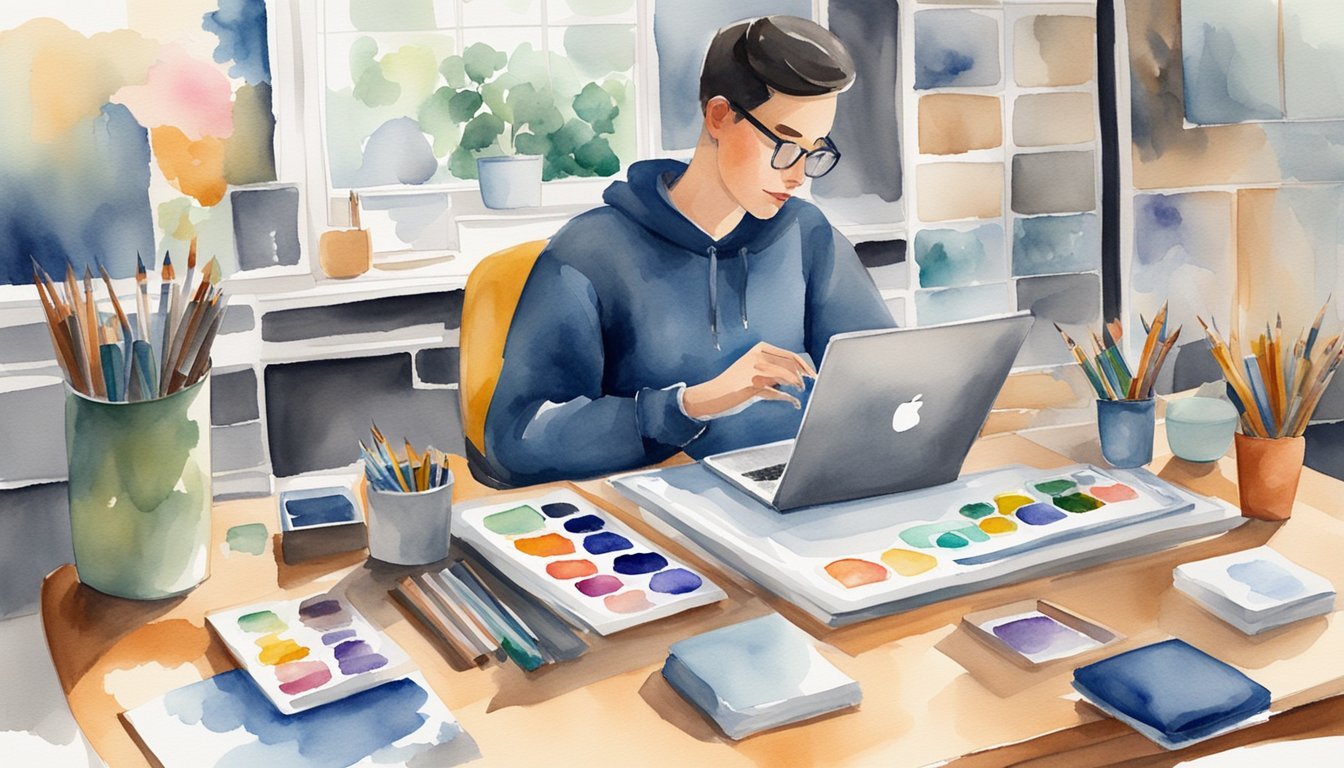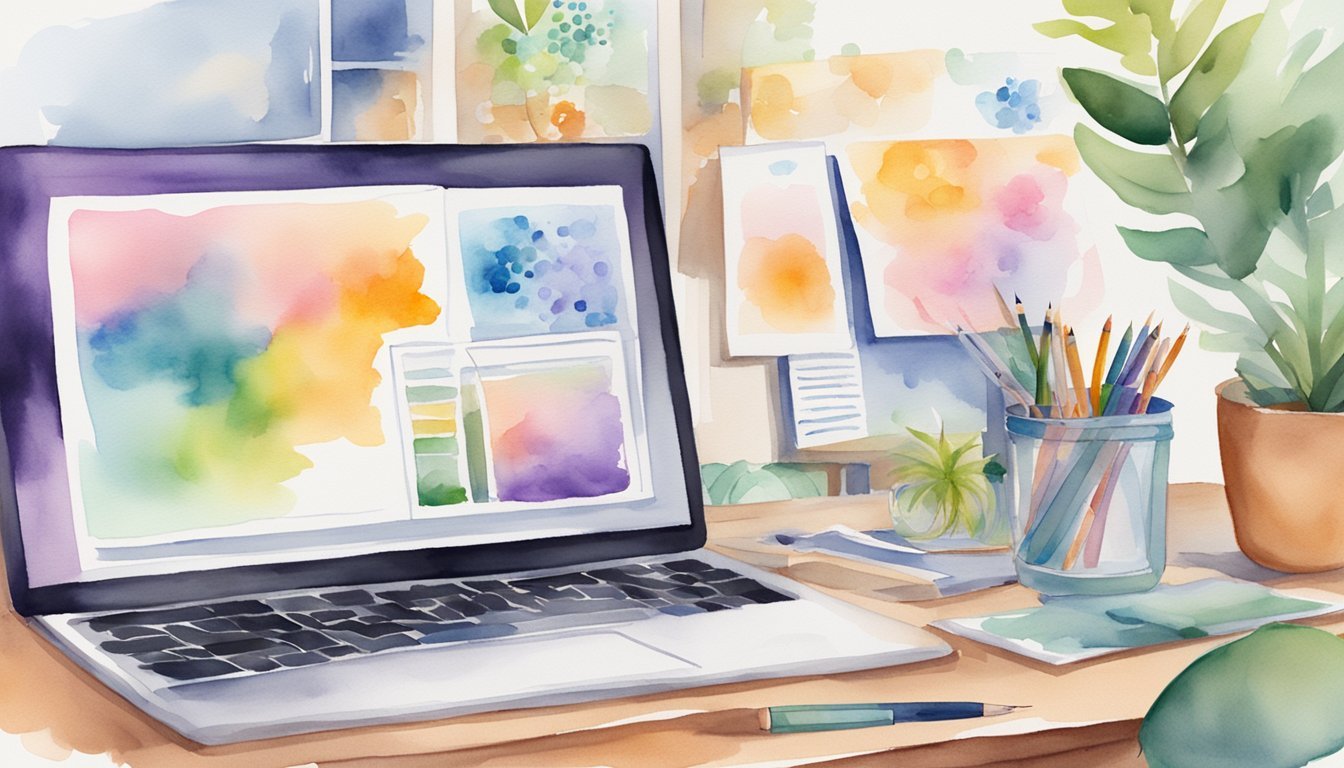Online Art Classes: Turn Your Passion into a Side Hustle

Looking to turn your creativity into a profitable side hustle? Online art classes are a fantastic way to enhance your skills from the comfort of your home.
With a range of online art classes tailored for both beginners and seasoned artists, you can find the perfect fit to level up your craft.

Whether you’re interested in drawing, painting, or digital art, there’s a course for you. Platforms like Skillshare offer a variety of classes that dive into different techniques and mediums, allowing you to explore and expand your artistic horizons.
By enrolling in courses from reputable sources such as Coursera, you can even earn certifications to boost your resume and credibility.
Embracing online learning can not only improve your artistic skills but also open up new opportunities for income.
From selling your artwork to taking commissions or even teaching your own classes, the potential is vast.
So why wait? Dive into the world of online art classes and start transforming your passion into a rewarding side hustle today.
Key Takeaways
- Online art classes help you improve your skills.
- You can explore various techniques and mediums.
- Turning your creativity into a side hustle is possible.
Getting Started with Online Art Classes
Starting online art classes can be an exciting way to explore your creativity.
Learn how to choose the right medium, find beginner-friendly courses, and master the basics for a great art journey.
Choosing Your Medium
When choosing your medium, think about what interests you most and what materials you already have.
Popular choices include acrylic and watercolor paints for vibrant, fluid art or pencil and ink for detailed, precise drawings. Oil paints are another option, though they can be trickier for beginners due to their slow drying time and specific requirements.
It’s also useful to consider how your chosen medium fits with your goals.
If you want to make quick, flexible pieces, watercolor or pencil might be best.
For rich, textured art, try acrylic or oil paints.
Many online classes cater to different mediums, so you can easily find one that matches your interests.
Art Classes for Beginners
Starting out with the basics is crucial for building your skills.
Online platforms like Skillshare offer a variety of beginner-friendly classes.
These courses often include step-by-step tutorials, helping you understand the fundamentals of painting and drawing.
Look for classes that cover essential topics, such as color theory, composition, and perspective.
Understanding these concepts will make a significant difference in your work.
Beginner classes on Online Art Lessons can help you get comfortable with your medium and techniques.
Remember, practice is key, so make sure to set aside regular time to work on your art.
Understanding the Basics
Before you can create complex pieces, you need to grasp the basics.
This includes learning how to hold and use your art tools properly.
For example, knowing how to control a paintbrush or a pencil makes a big difference in your results.
Online courses often have videos that demonstrate these techniques clearly.
Another important basic skill is understanding light and shadow.
Knowing how to use shading can add depth and dimension to your art.
Websites like Artists Network provide detailed explanations on different techniques.
By mastering these foundational skills, you’ll be well on your way to improving your craft and enjoying your artistic journey.
Exploring Advanced Techniques
Taking your art skills to the next level involves diving into complex areas like mastering illustration, advancing in painting, and creating professional animations.
Each of these fields offers unique techniques that can enhance your portfolio and open new opportunities for side hustles.
Mastering Illustration
Advanced illustration techniques include mastering anatomy, shading, and perspective.
You will learn how to draw realistic animal portraits and human figures with detailed muscle structure.
Practicing how to draw detailed landscapes or fantasy scenes can also help.
Techniques like digital illustration using software like Adobe Illustrator or Procreate allow for cleaner lines and vibrant colors.
Regular practice and studying works of professional illustrators provide inspiration and improvement in skills.
Consider exploring online lessons such as skull warrior drawings for a more challenging project.
Advancing in Painting
To advance in painting, you can experiment with various mediums like oil, acrylic, and pastels.
Understanding color theory and mixing paints to create accurate shades are crucial.
Try tackling complex subjects such as desert landscapes in oil or detailed portraits.
Learn techniques for painting light and shadows to add depth and dimension.
Blending and layering paints can create life-like textures and effects.
Joining advanced art classes such as those offered by The Art Studio NY can provide structured learning and feedback from professionals.
Professional Animations
Creating professional animations involves understanding the principles of movement and timing.
Learn how to storyboard your ideas and bring them to life using software like Adobe Animate or Blender.
Focus on creating smooth transitions and realistic motion.
Learning to sync animations with sound effects can enhance the final product.
Complex animations require skills in drawing multiple frames and understanding how to create consistency between them.
By honing these skills, you can offer your services for animated projects, opening doors for side hustle opportunities in freelancing or within creative studios.
Pursuing online courses and tutorials on animation can keep you updated with industry standards and software advancements.
From Hobbyist to Professional Artist
Turning your passion for art into a side hustle can be a rewarding journey.
To succeed, you’ll need to build a strong portfolio, effectively sell your art, and smartly market yourself.
Building Your Portfolio
Your portfolio is your most important tool.
It showcases your skills and unique style.
Focus on creating a diverse range of artworks that represent your abilities.
Include high-quality images and descriptions of each piece.
Use an online platform, like a personal website or social media, to display your portfolio.
Regularly update it with new works and consider including works in progress to show your creative process.
A strong portfolio can help you stand out to potential buyers and galleries.
Selling Your Art
To sell your art effectively, start by identifying your target market.
Think about who would be interested in your style and medium.
Explore online marketplaces like Etsy, eBay, or even your own website to reach a wider audience.
Participate in local art shows and fairs to gain exposure and network with potential buyers.
Pricing your art can be tricky.
Research similar works and consider your experience when setting prices.
Offer prints of your originals to appeal to different budgets.
Engaging with buyers and offering excellent customer service can help you build a loyal base.
Marketing Strategies for Artists
Marketing is essential to turning your hobby into a side hustle.
Use social media platforms like Instagram, Facebook, and Pinterest to share your work and connect with your audience.
Create engaging content like time-lapse videos, behind-the-scenes looks, and interactive stories.
Collaborate with other artists or influencers to reach a larger audience.
Email marketing can be a powerful tool.
Build an email list from your website visitors and social media followers.
Send regular updates about new works, upcoming shows, and special offers.
Remember, consistency and authenticity are key to building a strong online presence and attracting buyers.
Diving Into Design and Mixed Media

Learning about design and mixed media art offers many opportunities for creative expression.
This can be a rewarding side hustle for anyone looking to explore their artistic side.
Graphic Design Fundamentals
To start with graphic design, it’s important to learn the basic elements.
These include line, shape, color, texture, and space.
Understanding these can help you create balanced and engaging designs.
For example, lines can guide the viewer’s eye, while varying colors can evoke different emotions.
You should also get familiar with design software like Adobe Photoshop and Illustrator.
These tools are vital in the creative world, and learning them can open many doors.
Online courses often cover these fundamentals, allowing you to apply what you learn immediately.
Exploring Mixed Media Art
Mixed media art combines different materials like paint, ink, paper, and found objects.
This allows you to create unique and textured pieces.
Courses in this field can teach you techniques like layering and blending, which are crucial for creating depth and interest in your artwork.
For example, Jodi Ohl offers workshops focusing on color, layering, and design elements, while Bibby Gignilliat provides detailed modules and booklets.
Mixed media art classes can cater to all skill levels, making it an accessible and enjoyable side hustle.
Through these courses, you not only enhance your creative skills but also get the chance to sell your work online or at local markets.
This approach adds a practical dimension to your artistic journey.
The Digital Art Revolution
Digital art has transformed how you can create and express your creative vision.
With tools like Procreate and After Effects, you can experiment with styles, enhance your skills, and even turn your passion into a side hustle.
Creating with Digital Tools
Digital tools are game-changers for artists.
Programs like Procreate offer powerful brushes and layers, enabling you to draw, paint, and animate with precision.
It’s not just about creating still images; you can also dive into motion graphics with After Effects.
These tools allow you to explore various techniques easily.
They offer features like undoing mistakes with a quick tap, something traditional media doesn’t offer.
You can experiment with colors, textures, and effects that you might not have tried otherwise.
Another advantage is the ability to share your work instantly.
Whether you’re posting on social media or sending it to clients, digital art makes this seamless.
This instant sharing can attract commissions and freelance opportunities, turning your art into a profitable side hustle.
Finding Your Style in Digital
Finding your unique style is crucial.
Digital platforms provide endless possibilities to explore different art forms.
Whether you’re into character design, realistic portraits, or abstract art, programs like Procreate and Adobe Illustrator give you the tools to hone your craft.
It’s essential to follow professional artists and learn from their techniques.
Many artists offer online tutorials on platforms like YouTube, providing insider tips to refine your skills.
This learning can significantly speed up your progress and help you develop a distinctive style.
In the digital world, your style can set you apart.
Consistency in your work builds a recognizable brand, which is invaluable if you’re looking to monetize your art.
By blending creativity with digital tools, you can create a unique portfolio that attracts clients and followers, making your artistic endeavor profitable.
Photography and Fine Art Classes
Online courses in photography and fine art can help you master techniques, boost your creativity, and create professional-level artwork.
Learn how to capture stunning moments and refine your art to a fine level.
Capturing Moments
Learning to capture the right moment is crucial in photography.
Classes like those offered by CreativeLive teach you about lighting, composition, and timing.
These skills help you take your photos from simple snapshots to memorable images.
Online courses also focus on photography techniques specific to different settings.
For example, you might learn how to adjust your camera settings for low light or fast action.
This knowledge can be valuable if you’re considering photography as a side hustle or want to improve your personal photos.
Fine Art Techniques
Fine art photography is about creating artistic images that express an idea, emotion, or vision.
Classes like those on Domestika help you explore techniques to turn your photos into fine art pieces.
You’ll learn about blending different elements like words, video, and other media to create unique artwork.
These courses often include lessons on editing software to refine your images.
Learning these techniques can elevate your work to professional standards.
Whether you’re new to fine art or looking to improve your skills, these classes offer a great way to enhance your creative portfolio.
The World of Sculpture and Ceramics
If you want a side hustle that lets your creativity flow, consider diving into the art of sculpture and ceramics.
Whether you’re just starting or have some experience, there are online classes that make it easy to learn and grow.
Sculpture for Beginners
Starting with sculpture can seem intimidating, but it’s easy to find beginner-friendly classes online.
These classes cover the basics, from materials to simple techniques.
For instance, you can learn to sculpt a colorful character using paper mache.
These simple projects are perfect ways to hone your skills and gain confidence.
Another great option is modeling with clay.
Courses often provide a clear, step-by-step approach to creating a three-dimensional piece.
For example, Cristina Córdova’s classes focus on the human figure, combining traditional techniques with contemporary twists.
It’s a great way to start understanding the fundamental aspects of sculpture while working on exciting projects.
Advanced Ceramic Sculpture
If you already have some experience and want to refine your skills, advanced courses offer deep dives into complex techniques.
For those interested in ceramics, advanced classes often explore creative and intricate methods.
You can learn from seasoned artists like Cristina Córdova who specialize in figurative sculpting.
You’ll get to experiment with different methods and materials, such as modeling clay to create lifelike forms or adding detailed surface decorations.
More challenging projects, like sculpting a human head or full-face portraits from clay, can push your skills to new levels.
To improve even more, you can join platforms like The Ceramic School which offers various workshops and classes.
Here, you can learn techniques for creating unique ceramic pieces and explore complex patterns and surface decoration using computers and other modern tools.
Choosing the Right Online Platform

Choosing the best online art platform is essential to fit your needs and budget.
Understanding the differences between free and paid classes and knowing what benefits subscriptions offer can help you make an informed decision.
Free vs. Paid Classes
Free online art classes are great for beginners.
You can find these on platforms like YouTube or OnlineArtLessons, which offers a free trial class.
Free classes are attractive because they don’t cost anything, but they might lack the structure and depth you need for more advanced skills.
Paid classes, such as those from Skillshare, offer more in-depth content and better organization.
Paid platforms often provide a more comprehensive learning experience, covering a range of subjects like animation, game design, and visual effects.
Consider your goals and budget to decide which option suits you best.
Paid classes can be a good investment if you’re serious about improving your skills or want to pursue art as a side hustle.
Membership and Access
Many online art platforms offer membership options, giving you unlimited access to their courses.
For example, New Masters Academy offers a membership with access to a diverse array of high-quality classes.
With a membership, you can take courses on various subjects whenever you want, fitting your learning into your schedule.
Memberships often come with perks like community forums, personalized feedback, and downloadable resources.
These benefits can be valuable, especially if you’re looking to connect with other artists and get more support as you learn.
If you plan to take multiple courses and want the flexibility to learn at your own pace, a membership might be the way to go.
It can provide a more enriching learning experience than one-off purchases.
The Certification Journey

Getting certified in online art classes can boost your portfolio and help you stand out in the field of art education.
Having certificates from top programs shows your dedication and can open up professional opportunities.
Acquiring Recognized Certificates
To get recognized certificates, you need to choose the right courses.
Platforms like Coursera offer a variety of art classes that provide certificates upon completion.
These programs often include coursework from industry leaders and reputable institutions.
When you finish a course, you’ll usually need to complete assignments or projects to prove your skills.
The certificate you earn can highlight your knowledge and abilities in specific areas like graphic design or digital art.
Using Certifications to Advance
Using certifications can greatly benefit your career.
Certificates from well-known programs signal to potential clients, employers, or collaborators that you are a professional with verified skills.
You can also use these credentials to build a more impressive portfolio.
Whether you’re looking to improve your side hustle or advance in your career, these certifications can make a big difference.
For example, becoming an OMA Facilitator can help you lead workshops and classes in your community, offering you more opportunities to share your expertise in art.
Maintaining Inspiration and Creativity
Keeping your inspiration and creativity alive is vital for your art journey, especially if you’re juggling it as a side hustle.
Dive into art history and engage with the art community to spark new ideas and keep your passion burning.
Exploring Art History
Studying art history gives you a broad perspective on different artistic styles and techniques.
By examining works from various periods, you can discover unique approaches that can be incorporated into your own projects.
Focus on famous artists and movements that intrigue you.
This deep dive can inspire your current work or future projects.
Learning about the challenges and triumphs of past artists can also motivate you to persist in your creative journey.
Check out online courses, like those on Skillshare, which offer lessons in art history alongside practical skills.
Combining theoretical knowledge with practical application can greatly enhance your artistic skills.
Connecting with the Art Community
Engage with fellow artists to keep your creativity flowing.
Join online communities, participate in forums, or attend virtual meetups to share your art and get feedback.
Platforms like Artsy offer courses that emphasize community interaction, which can be incredibly motivating.
Connecting with other artists allows you to exchange ideas and techniques.
This collaboration can lead to new projects and side hustle opportunities.
It’s important to be active in these communities to stay inspired and foster a supportive network that encourages continuous growth.
Frequently Asked Questions

When considering online art classes, it’s important to know the best options for beginners, tailored programs for teens, and the overall effectiveness.
You’ll also want to look into free classes and tips for choosing the right platform, especially if you’re thinking of art as a side hustle.
What are some recommended online art classes for beginners?
For beginners, Visual Arts Passage offers structured programs that build skill over time.
These programs include 10 classes, each lasting 3 hours.
Another option is Artventure Network, managed by Sandy.
It provides a community for students and artists to ask questions and share their work.
Where can teens find online art classes tailored for them?
Teens may find specialized programs through platforms like Brenda Rowe Artwork.
These classes often include weekly lessons via Zoom and cater to different skill levels with hands-on projects.
Can you actually learn art online effectively?
Yes, you can learn art online effectively.
Many platforms, such as Visual Arts Passage, offer comprehensive and well-structured courses that build upon previous lessons, ensuring a progressive learning experience.
Are there any free digital art classes available online?
Free online art classes can be found on several platforms.
Websites like YouTube and certain community colleges offer free tutorials and workshops.
While free classes may not provide the same depth as paid ones, they can be a good starting point.
How do I choose the best online art platform for my needs?
Choosing the right platform depends on several factors.
Consider the course content, the format, and the feedback mechanism.
For instance, ARTiClass offers programs in English with detailed syllabi available online.
What options are available for adults looking to take art classes online?
Adults seeking to take art classes online have multiple options.
Platforms like ARTiClass provide workshops with assignments to reinforce learning.
Additionally, Visual Arts Passage offers advanced programs aimed at skill and professional development.
Taking an online art class can be a great way to expand your skills, whether you’re looking to develop a side hustle or simply enjoy a creative outlet.

